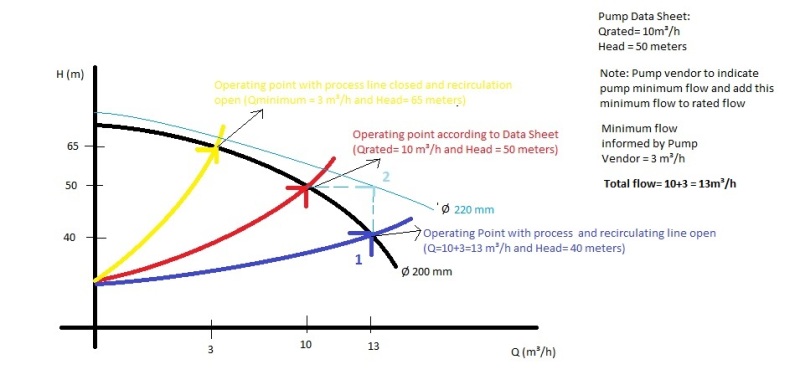Hello,
I have the following situation:
Process Data Sheet indicates:
-Qrated: 10 m³/h
-Head 50 meters
- General Note: "Pump to operate with minimum flow bypass line with restriction orifice. Pump Vendor to indicate Pump minimum flow, and this minimum flow shall be added to rated flow (Qrated)."
After selecting a pump according to Process Data Sheet (operating point: 10 m³/h and 50 meters), pump vendor informed minimum flow for the rated impeller 3 m³/h.
So, I understand that the pump shall operate with 13 m³/h (10 m³/h to process line + 3 m³/h always recirculating in the bypass line with RO). But when operating with 13 m³/h, the developed Head will be 40 meters with the rated impeller.
My question is: Operating with this smaller Head of 40 meters instead of 50 meters will be ok? Because Process required 50 meters.
Thanks.
Peter
I have the following situation:
Process Data Sheet indicates:
-Qrated: 10 m³/h
-Head 50 meters
- General Note: "Pump to operate with minimum flow bypass line with restriction orifice. Pump Vendor to indicate Pump minimum flow, and this minimum flow shall be added to rated flow (Qrated)."
After selecting a pump according to Process Data Sheet (operating point: 10 m³/h and 50 meters), pump vendor informed minimum flow for the rated impeller 3 m³/h.
So, I understand that the pump shall operate with 13 m³/h (10 m³/h to process line + 3 m³/h always recirculating in the bypass line with RO). But when operating with 13 m³/h, the developed Head will be 40 meters with the rated impeller.
My question is: Operating with this smaller Head of 40 meters instead of 50 meters will be ok? Because Process required 50 meters.
Thanks.
Peter

